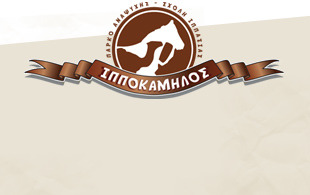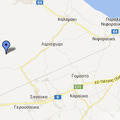Chickens
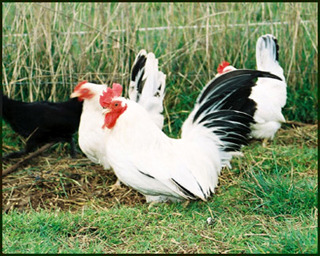 |
Japanese Bantam ChickenJapanese Bantams are a miniature sized chicken with distinct features of large comb, large wings that touch the ground, arched tail feathers and very short legs. Japanese Bantams are a great show bird, good pets, require little feed and space. The Jap bantam has graced the gardens of the Japanese aristocracy for well over 350 years. Historical evidence suggests that the Japanese Bantam originated in Southeast Asia, where it is still raised today. Japanese Bantams enjoy a high degree of popularity in Malaysia, and are very common in Java, which is now part of Indonesia. Japanese Bantams began to appear in Japanese art around the year 1635. It also appears in Dutch art of the same era. This suggests that Dutch spice traders probably carried the Chabo as gifts to the Japanese from the Asian spice ports, such as Hoi An (Vietnam) and likely from Java, which part of Dutch colonial area on that time. |
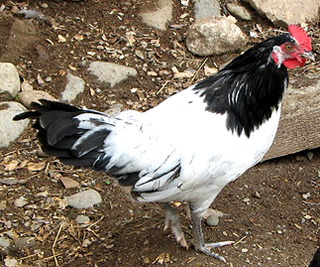 |
Lakenvelder ChickenLakenvelders or Lakenfelders are a breed of chicken developed in the 1830’s in Germany despite their Dutch name.Characteristics of the breed are black head, collar, and tail, white body, white skin and slate colored legs. The Lakenvelder is a flighty breed that is a good forager if allowed to free range. While it does well on range, it also bears confinement well. It has a small 4-5 pound body and is a good layer of small to medium a white or cream eggs. The Lakenvelder originated in the Levant from Egyptian Fayoumi and Persian progenitors. It was developed as its own breed for centuries in Palestine. Roman Jewish immigrants brought this ancient breed to the Westfalen area of Germany during the Roman era. |
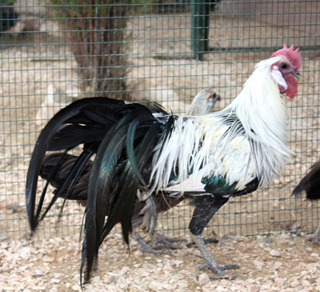 |
Phoenix ChickenThe Phoenix is one of many breeds of chicken that belong to the long-tail fowl bred in Japan for a thousand years. Phoenix are noted for extreme tail growth on the cocks(males) and has been known to exceed twenty feet in length. Phoenix male chickens do not molt their sickle feathers while female Phoenix moult normally. Japanese breeders through the centuries have gone to great pains in the creation and perpetuation of the species. The Phoenix breed was accepted into the American Poultry Association Standard of Perfection in 1974 with the Gold and Silver varieties. Recently the Black Breasted Red variety has also been included. |
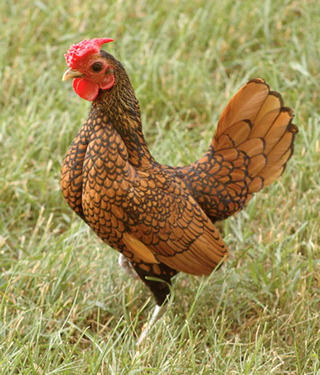 |
Sebright ChickenIn accordance with the intentions of their creator, the Sebright is an ornamental chicken. As a true bantam, all Sebrights are very small in stature; males weigh an average of 625 gr. and females 570 gr. Their short backs, proportionally large breasts, and downward–pointing wings combine to create an angular, jaunty look. All Sebrights have plumage that is laced around the edges evenly with black, on a base of either dark gold or whitish silver. Sebrights have unfeathered legs with slate–blue skin. Sebright roosters carry a rose comb covered with fine points, and a small spike that sweeps back from the head. Sebrights are neither prolific egg layers, nor outstanding meat birds. Hens rarely go broody and chicks usually have high mortality rates. Adults are generally hardy birds, but are especially susceptible to Marek's disease. Due to their small size and relatively large wings, they are one of a minority of chicken breeds that retains a strong flying ability. |
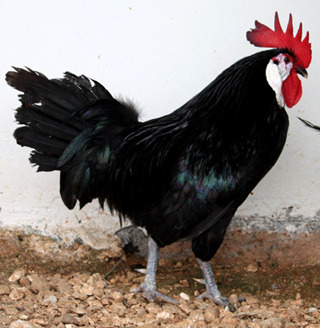 |
Spanish Black ChickenThe Black Spanish chicken is a Spanish breed of chicken. They are thought to be the oldest breed of fowl in the Mediterranean class. The British have records dating back to 1572 referring to this chicken. This breed was admitted into the American Poultry Association in 1874. This breed originated in Spain, and came to the Americas through the Caribbean Islands. The have glossey black plumage, weigh 6-7 pounds, and are closely related to the Minorca and Castilian breeds. Their most distinguishing feature are their white, low hanging ear lobes, which are actually overdeveloped. They have a single comb, four toes, and no crest. Hens are non-setters that lay eggs that are large, and chalk white in color, with an average of three a week, 150-180 eggs a year. |
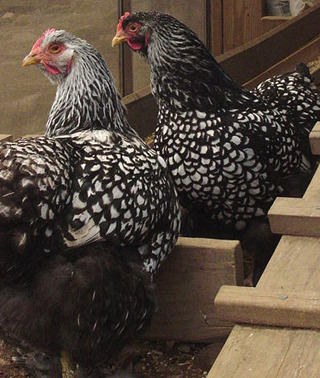 |
Wyandotte ChickenThe Wyandotte is a breed of chicken originating in the United States. The first examples of the breed appeared in 1870s. The Wyandotte is a medium sized breast with a rose comb and clean legs. The chicken feathers are broad and loosely fitting. The area around the vent is very fluffy. The legs are yellow, although some silver laced may have grey. They occasionally go broody. The hens (females) will lay around 200 eggs a year with an exceptional hen laying around 240 eggs a year. The eggs are brown or tinted. The hens weigh around 6 pounds and the cocks weigh around 8 1/2 pounds. They tend to be quite friendly, and not flighty, and so make good pets for people. They are also very vocal, uttering soft clucks on a regular basis. |
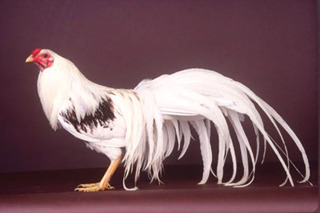 |
Yokohama ChickenThe Yokohama is a breed of chicken that originated in Germany in the 19th century. It was developed from two different Japanese Cultural Monument breeds, the principle progenitor is the Minohiki or "Saddle Dragger". The Yokohama is primarily ornamental for many but it is actually an excellent breed for suburban poultry enthusiasts because of its calm demeanor. Better strains of this important breed are also relatively quiet in voice. It lays cream or tinted eggs. If fed a typical lay pellet it will only produce on an average, one egg a week. Fed a higher quality ration with generous proportions of fish and animal protein and fat, it produces an egg a day and all through the winter. The Yokohama is a relatively small breed,only four to five pounds at the very largest. The most distinguished feature of this fowl is its unusual plumage, unique in pattern from all other domestic fowl. It is also celebrated for its long, elegant tail. It comes both in the bantam and standard sizes. |
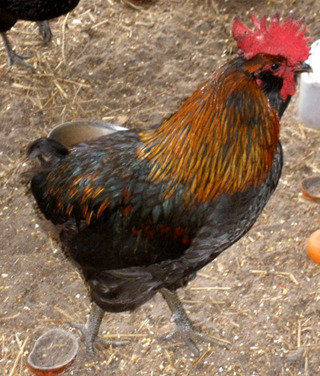 |
Araucana ChickenThe Araucana, also known in the USA as a South American Rumpless, is a breed of chicken originating in Chile. The Araucana is often confused with other fowl, especially the Ameraucana and Easter Egger chickens, but has several unusual characteristics which distinguish it. They lay blue eggs, have feather tufts near their ears, and a tail. The average weight of males is 2,2 kg and for femalew 1,8 kg.To comply with the north American standard they must have no tail and are rumpless. The ancestors of the modern Araucana chicken were purportedly first bred by the Araucanians Indians of Chile hence the name "Araucana." The Araucana as we know it today is a hybrid of two South American breeds: the Collonca (a naturally blue-egg laying, rumpless, clean-faced chicken) and the Quetro (a pinkish-brown egg layer that is tailed and has ear-tufts). |
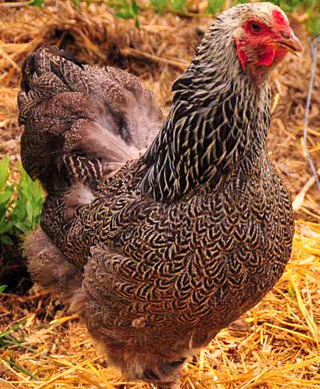 |
Brahma ChickenBrahmas are an Asiatic breed of chicken, originating in the Brahmaputra region in India where they were known as "Gray Chittagongs." Their heritage is unclear, but they are believed to be closely related to the Jungle Fowl (Gallus Gigantus) and the Cochin (chicken). The first Brahmas were brought to the U.S. from India in 1846, and were used as a utility fowl for their edibility and generous egg laying and hardiness even during the winter months, although today they are kept mainly for ornamental purposes as selection for utility has taken a back seat to selection for appearance. Brahmas are massive in appearance, in part due to profuse, loose feathering and feathered legs and toes. The males weight about 1,8 kilos and females about 1,36 kilos. Brahmas are calm, friendly birds that make good pets or exhibition fowl. |
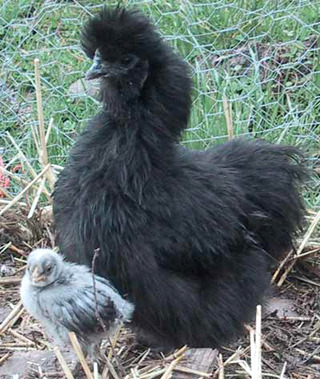 |
Silkie ChickenThe Silkie (sometimes spelled Silky) is a breed of chicken named for its unique, fluffy plumage, which is said to feel like silk. The breed has several other unusual qualities, such as dark blue flesh and bones, blue earlobes, and five toes on each foot (most chickens only have four). In addition to their distinctive physical characteristics, Silkies are well known for their calm, friendly temperament. They lay about three eggs a week, they are commonly used to hatch eggs from other breeds and bird species. Silkies most likely originate in China, but other Southeast Asian countries are also sometimes proposed. The first written account of the breed comes from Marco Polo, who mentioned chickens with fur-like plumage in his Asian travelogues in the 13th century. Silkies are often considered a bantam breed, but this varies according to region, and many breed standards class them officially as large fowl. However, even "large" Silkies are relatively small chickens, with standard size males weighing only 1.8 kilos, and females weigh 1.36 kilos. |


